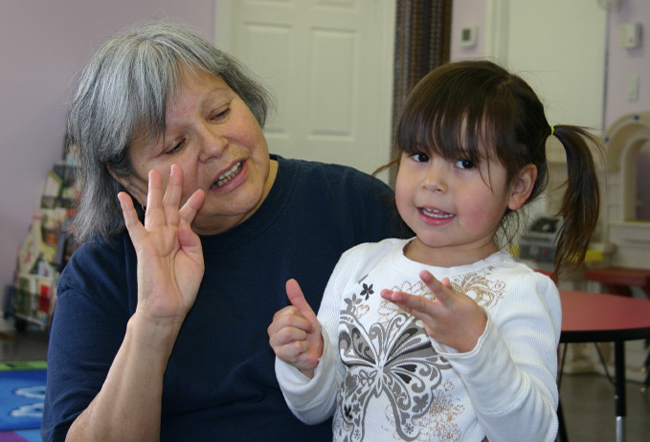‘Gchi-nendama’: Beausoleil language instructors

By Sharon Weatherall
BEAUSOLEIL FN – Roseanne Monague is one of seven Christian Island language-keepers who participated in a 160-hour immersion program to equip them to pass on Anishinaabemowin to young community members
For 13 years she has been working at the First Nation’s day care, teaching native language to tots. Growing up, her family spoke traditional Anishinaabemowin in the home but she attended Indian Day School where students, including her siblings, were severely reprimanded and strapped for speaking their own language.
“I put my language to the back burner because they told us our language was not important when it came to getting jobs,” says Roseanne. “But ever since attending Lakehead University in 1992 I have always worked teaching language. I notice now that the focus of language conferences is turning to the way it was taught to us — learning through speaking.”
Anishnaabemowin Language Revitalization is a project funded through Canadian Heritage, Beausoleil First Nation Chief and Council, and BFN Social Services and Education. Participants in Immersion Instructor Training were all fluent speakers.
“I loved the project and the way the instructors (Barb Nolan and John Paul Mantano) taught us,” says Roseanne. “We all worked together. The commitment to the program was most important to me; when I signed up I put everything else aside. I liked the philosophy and how the whole course fit into the natural way of learning. I have found the immersion program goes back to the way we were taught as children –using facial expressions, body movements and hand gestures.”
As a child Monague didn’t know words, but used hand language to learn and when Elders talked to children they told stories at the child’s level. The three and four year olds she now teaches absorb the language as the first step to learning for a good basic understanding when they enter kindergarten. Monague shows her pupils a picture and does the actions to help them to understand.
For example, in her class “miptoo” means running with an image of a figure doing so; “niimi” means dancing, “gchi-nendama” means happy, “ekozi’ mean I’m tired and “wiisni” means eating — all of which can be demonstrated by facial expression and body movements. The children sing songs and count to ten in Ojibway.
“They use the language at home but the parents don’t understand or know what they are saying,” says Monague. “We have taught the kids to be the learners and also the teachers to their parents by sharing their knowledge.”
Monague’s siblings Gloria King and Leon King — both community Elders and program graduates — are now sharing their knowledge at the Guiding Lights Senior Centre.
“Our instructors believed that the language is slowly disappearing but realized it is still retained on Christian Island,” says Leon King. “It is thriving here.”
“They taught us like students in school, and we learned a lot of computer skills. That’s why we need a building with computers to encourage us to get support from the community”
Myrtle Jamieson, a language instructor for over 20 years, also participated in the Immersion Instructor Training, which was offered Fridays and weekends from December to the end of March.
“I love my language — it’s the heartbeat of my life,” says Jamieson who shares her new skills at Christian Island Elementary School, another community language “nest”.
“When I speak my own language it is emotional for me and I feel that not enough people want to learn it. The program is an effort to bring the language back at all levels. Since taking it I find the kids really listen and watch me. That’s how they learn. If I say the same sentence every day they will pick it up.”
Gloria King looks forward to using new technology to pass on Anishinaabemowin to younger community members. King has been running summer language camps with her daughter for nine years.
“We want to reach all ages and encourage them to speak the language. We would like to start a program once we have a building and use computer to start a website or blog to help communicate the program to others. The computer is a wonderful tool if you know how to use it.”


